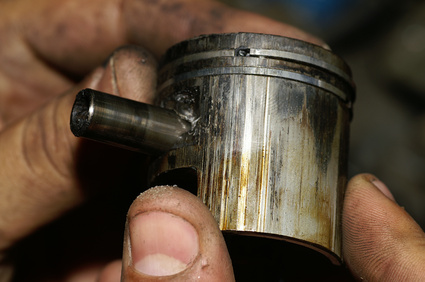
Carburetors are responsible for guaranteeing the fuel/air mixture in a scooter engine occurs correctly. Combustion engines require this mixture to be able to operate. Once the mixture is compressed by the piston into the cylinder a spark plug fires, exploding the mix and pushing the piston back through its cycle. This in turn creates power. If a carburetor is not set up correctly, the mixture will be off and the engine will run poorly. Understanding how the carburetor setup works can avoid engine flooding (too much gas) or running lean (too little gas).
Remove the scooter body panels so you can access the carburetor easily. Turn the scooter on and have it run in idle. Find the idle screw on your carburetor model. Use a flathead screwdriver to twist the idle screw 1/4 of a turn at a time to lower or increase the idle setting. Adjust the screw until the scooter idle ticks over consistently without the scooter dying out or the engine racing.
Turn the scooter off. Use the flathead screwdriver to loosen the banjo bolts on the intake and exist rubber manifolds holding the carburetor onto the engine. Remove the carburetor and open up the top that the throttle cable goes into. Pull the throttle slide assembly out. Turn the carburetor body upside down now that it is loose from the throttle and loosen the bottom of the carburetor with a crescent wrench. Expose the insides.
Examine the current jets and needles inside the carburetor body. Replace the jets and needles with the appropriate sizes for your region and altitude above sea level per your engine size. Refer to your carburetor manufacturer for the specific requirements or call your local scooter dealer by phone for a quick check. Insert the correct jets as instructed. Increase the jet size for more fuel flow and decrease the size for less fuel. Apply new carburetor body gasket and close up the carburetor bottom. Tighten it with a crescent wrench.
Reattach the carburetor to the throttle cable by re-inserting the throttle slide and securing the top to the carburetor body with a crescent wrench. Turn the carburetor over until you see the air/fuel mixture needle on the side of the body. Adjust the setting with a flathead screwdriver. Turn the needle all the way into the body and twist it out the number of settings per your scooter technical manual. Call your scooter dealer for a technical setting if no manual is available.
Reattach the carburetor to the intake and outflow rubber manifolds. Secure it again with the banjo bolts and a screwdriver. Pull the throttle to determine if any slack exists. Twist the adjuster that the throttle cable enters to go into the carburetor to tighten the distance on the throttle cable. Do so until the slack disappears or is reduced.
Start the scooter and let it idle to confirm the engine is running correctly after your adjustments are made. Take the scooter for a test ride slowly. Then pick up speed. After 10 minutes pull over, turn off the scooter, and pull out the spark plug with a socket wrench. Redo the carburetor settings to less fuel if the plug is black and oil. Change the settings to more fuel if the plug tip is chalky white.